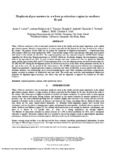Please use this identifier to cite or link to this item:
http://www.alice.cnptia.embrapa.br/alice/handle/doc/1001291Full metadata record
| DC Field | Value | Language |
|---|---|---|
| dc.contributor.author | LEIVAS, J. F. | pt_BR |
| dc.contributor.author | TEIXEIRA, A. H. de C. | pt_BR |
| dc.contributor.author | ANDRADE, R. G. | pt_BR |
| dc.contributor.author | VICTORIA, D. de C. | pt_BR |
| dc.contributor.author | BOLFE, E. L. | pt_BR |
| dc.contributor.author | CRUZ, C. R. | pt_BR |
| dc.date.accessioned | 2014-12-02T11:11:11Z | pt_BR |
| dc.date.available | 2014-12-02T11:11:11Z | pt_BR |
| dc.date.created | 2014-12-02 | pt_BR |
| dc.date.issued | 2014 | pt_BR |
| dc.identifier.citation | Proceedings of SPIE, v. 9239, p. 923924-1 - 923924-8, 2014. | pt_BR |
| dc.identifier.isbn | 0277-786X | pt_BR |
| dc.identifier.uri | http://www.alice.cnptia.embrapa.br/alice/handle/doc/1001291 | pt_BR |
| dc.description | Wheat (Triticum aestivum) is the second most produced cereal in the world, and has major importance in the global agricultural economy. Brazil is a large producer of wheat, especially the Rio Grande do Sul state, located in the south of the country. The purpose of this study was to analyze the estimation of biophysical parameters ? evapotranspiration (ET), biomass (BIO) and water productivity (WP) ? from satellite images of the municipalities with large areas planted with wheat in Rio Grande do Sul (RS). The evapotranspiration rate was obtained using the SAFER Model (Simple Algorithm for Retrieving Evapotranspiration) on MODIS (Moderate Resolution Imaging Spectroradiometer) images taken in the agricultural year 2012. In order to obtain biomass and water productivity rates we applied the Monteith model and the ratio between BIO and ET. In the beginning of the cycle (the planting period) we observed low values for ET, BIO and WP. During the development period, we observed an increase in the values of the parameters and decline at the end of the cycle, for the period of the wheat harvest. The SAFER model proved effective for estimating the biophysical parameters evapotranspiration, biomass production and water productivity in areas planted with wheat in Brazilian Southern. The methodology can be used for monitoring the crops' water conditions and biomass using satellite images, assisting in estimates of productivity and crop yield. The results may assist the understanding of biophysical properties of important agro-ecosystems, like wheat crop, and are important to improve the rational use of water resources. | pt_BR |
| dc.language.iso | eng | eng |
| dc.rights | openAccess | eng |
| dc.subject | Water production | pt_BR |
| dc.title | Biophysical parameters in a wheat production region in southern Brazil. | pt_BR |
| dc.type | Artigo de periódico | pt_BR |
| dc.date.updated | 2014-12-02T11:11:11Z | pt_BR |
| dc.subject.nalthesaurus | Evapotranspiration | pt_BR |
| dc.subject.nalthesaurus | Biomass | pt_BR |
| dc.subject.nalthesaurus | Wheat | pt_BR |
| dc.description.notes | Presented at the 16th Remote Sensing for Agriculture, Ecosystems, and Hydrology. | pt_BR |
| riaa.ainfo.id | 1001291 | pt_BR |
| riaa.ainfo.lastupdate | 2014-12-02 | pt_BR |
| dc.identifier.doi | 10.1117/12.2067477 | pt_BR |
| dc.contributor.institution | JANICE FREITAS LEIVAS, CNPM; ANTONIO HERIBERTO DE C TEIXEIRA, CNPM; RICARDO GUIMARAES ANDRADE, CNPM; DANIEL DE CASTRO VICTORIA, CNPM; EDSON LUIS BOLFE, CNPM; CAROLINE R. CRUZ, PUC-CAMPINAS. | pt_BR |
| Appears in Collections: | Artigo em periódico indexado (CNPM)  | |










